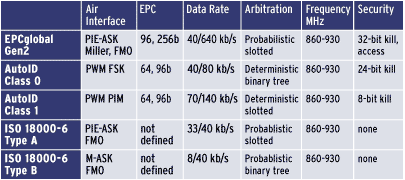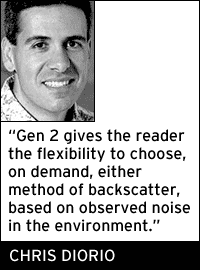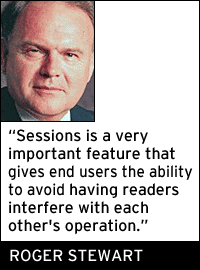For much of the past year, the buzz about Electronic Product Code technologies has focused on EPCglobal’s second-generation UHF standard. Yet, for all the attention that has been paid to Gen 2, few end users have a good understanding of how this new air-interface protocol differs from the first-generation EPC standards (Class 0 and Class 1).
The biggest difference between Gen 1 and Gen 2 is that there is now a single global protocol. The first-generation EPC had two protocols, Class 0 and Class 1, and the same reader could not read both unless it was a multiprotocol reader. The International Organization for Standardization (ISO) also approved two UHF air-interface protocols, 18000-6A and 18000-6B, as international standards, so there have been four UHF standards. EPCglobal has submitted the Gen 2 protocol to ISO for approval, which could happen in about a year, which would create one UHF protocol globally.
|
|
“That is a big deal,” says Sue Hutchinson, director of product management at EPCglobal US in Lawrenceville, N.J., and the person who facilitated the development of the Gen 2 protocol. “Having more than one standard protocol creates confusion about what technology end users should buy. Vendors also have to figure out which protocol to base their products on. [Gen 2] brings us all together under one protocol, which will bring more vendors into the market and drive prices down for the end users.”
Another important aspect of the UHF Gen 2 protocol is it was designed to optimize performance in different regulatory environments around the world. Europe’s communications authorities recently adopted reader regulations that are more relaxed, but the new rules are still quite stringent compared with those in the North America (see New ETSI RFID Rules Move Forward). Because the Gen 2 protocol uses the available radio spectrum more efficiently, it will provide better performance in Europe than any other UHF protocol. But Asia is still a wild card. “Asian regulations are changing, but we did our best to build in flexibility,” Hutchinson says.
The protocol was also designed to be used for higher classes of EPC tags, so a reader could read an active tag with a sensor or a simple tag with just a unique ID. “Gen2 creates a good foundation for higher-function products, such as Class 2 and Class 3 tags and readers,” says Tom Pounds, VP of corporate development at Alien Technology, a Morgan Hill, Calif.-based system provider. “The protocol anticipates those higher-function products and gives the industry a strong foundation to build on.”
In part one of this two-part special report, we explain the most important new features in the Gen 2 air-interface protocol. Part 2, to be published next week, will explain some of the key improvements that were built upon the original EPC protocols.
Keep in mind that although all Gen 2 tags must support all features of the protocol, readers need not support all the features and improvements built into the protocol. Therefore, a current UHF reader can be upgraded with new hardware, new firmware or both to enable it to read Gen 2 tags. But an upgraded reader might not support some of the key features of the Gen 2 standard.
Dense-reader mode
The Gen 2 standard allows readers to operate in three different modes: Single-reader mode, multi-reader mode and dense-reader mode. To function optimally, readers will need to operate in dense-reader mode when more than 50 readers are present within a building, such as within a distribution center. Dense-reader mode is designed to prevent readers from interfering with one another, which could be a problem if many readers are used in a confined space, particularly in Europe and other regions where only a small band of the UHF spectrum has been allotted for RFID systems. If you think of the UHF spectrum as a highway, you can have many vehicles on an eight-lane freeway without their colliding into one another. But if it’s a two-lane highway, the chances of a collision are much greater so rules governing how they can use the road must be strictly enforced to prevent collisions.
Two critical components of dense-reader mode are an agreed-upon way to use the UHF spectrum and the ability to transmit within a narrow channel of the spectrum. Using our highway analogy, readers are large trucks (readers emit a strong RF signal), and tags are bicycles (they reflect back a very weak RF signal). Dense-reader spectral allocation effectively divides the UHF frequency band (i.e., the highway) into multiple lanes. The trucks are allowed to use some lanes, and the bicycles are allowed to use other lanes, but trucks and bicycles don’t share a lane, which prevents the trucks from running over the bicycles. The Gen 2 standard requires readers to use different frequency “lanes” from tags, so that tags can be heard even when there are readers operating simultaneously, in adjacent lanes.
Dense-reader mode also requires readers to use a narrow spectral mask. Again using the highway analogy, dense-reader mode requires trucks to stay within their lanes, rather than drifting into the bicycle lanes. If a truck drifts into a bicycle lane, it could run over many bicycles. Similarly, if a reader’s signal, which can be a million times more powerful than a tag’s response, leaks into a tag lane it will mask the tag transmissions and prevent other readers from seeing any tags in that lane. For this reason, dense-reader mode tightly restricts reader transmissions to their allotted lane and requires the reader to keep its transmit energy within that lane.
Dense-reader mode requires the reader to use a method of encoding the backscatter signal (the method by which the tag reflects back radio waves to the reader) called Miller subcarrier. Miller subcarrier uses a narrow spectrum for the tags to send back their signal and fits the tag’s backscatter signal between the channels used by the reader. That way the RF emissions from the readers don’t overwhelm the signals coming back from the tags.
“Some readers emit a lot of noise,” says Steve Smith, chief technology officer and founder of Alien Technology. “You don’t want the RF bandwidth completely used up by a buzz saw when you are trying to listen to Mozart. We put dense-reader mode into the protocol to regulate how the airwaves are used and reduce the noise put out.”
Dual methods of backscatter encoding
The Gen 2 protocol also supports another method of encoding the backscatter signal called FM0. The purpose of allowing the reader to use either FM0 or Miller subcarrier was to improve performance not just when there are many readers in a facility but also when there is a lot of noise in the area. (Noise is extraneous electromagnetic energy that interferes with the ability of tags and readers to communicate. It can be caused by machinery, other wireless devices or the readers themselves.)
FM0, a format used effectively in the current ISO standards, is fast but susceptible to interference. Miller subcarrier is slower but works better in noisy environments. Using the highway analogy again, FM0 allows trucks and bicycles to share a lane. FM0 works well when there are few trucks, because it allows fast tag reads (i.e., the bicycles get to drive in the fast lane). Miller subcarrier, by contrast, gives a reader the flexibility to move the tags into other lanes to get around trucks or around other obstacles (i.e., to get around noise). Miller is slower, but makes it possible to read tags when FM0 would fail.
“Miller subcarrier allows readers to use new and advanced filtering techniques to separate a tag’s response from noise and from other readers,” says Chris Diorio, cochair of EPCglobal’s EPCglobal Hardware Action Group (HAG), which developed the Gen 2 protocol, and founder and chairman of Impinj, a Seattle-based manufacturer of passive RFID tags and a licensor of Gen 2 RFID readers. “Gen 2 gives the reader the flexibility to choose, on demand, either method of backscatter, based on observed noise in the environment.”
Secure read-write memory
First-generation EPC Class 0 tags are programmed at the factory, when the chips are made. First-generation Class 1 tags are user programmable, meaning that an end user company can write EPCs to the tag after taking delivery. In most applications today, Class 1 tags are programmed one by one as they come off a spool.
Gen 2 tags are field programmable, meaning that readers can write information to tags even if they are attached to cases on a pallet or a conveyer belt. Gen 2 tags will feature three required memory banks—one bank for storing the EPC, one for passwords, one for tag identification (the tag stores information about itself)—and an optional bank for memory that end users can use for whatever purpose they wish (one of the few optional features tags can have). User memory could be to store codes to indicate where products are being shipped to, for instance.
The memory banks can be locked temporarily or permanently. So a product supplier might write an EPC to a tag and lock it permanently. It might then write the identification number of a store that the product is being shipped to in the optional user memory. The supplier might lock that memory with a password to avoid having it overwritten, but a manager in the store’s distribution center might have the option of unlocking the memory (if the manufacturer supplies the password), changing the store ID to indicate the destination has changed, and then locking the memory again.
The Q algorithm
One issue with the Gen 1 protocols is that they require RFID readers to use the tags’ unique serial numbers to singulate tags (to identify them uniquely). If two tags have the same EPC, they confuse the reader. Some retailers are considering using tags with the same EPC—that is, information similar to what they have on bar codes today—as an interim measure as they move from bar codes to RFID and prepare their software systems to handle unique IDs. Those retailers asked EPCglobal’s Hardware Action Group to make it possible to singulate the tags even if two or more tags have the exact same EPC.
Alien Technology’s Steve Smith came up with a solution that enables a Gen 2 reader to count Gen 2 tags—for the purpose of taking inventory, for instance—even when they have the same EPC or no serial number. The reader can do this without broadcasting the tags’ EPCs, which makes the system more secure. (Since the reader doesn’t transmit a message “Tag 12345, are you out there?” it prevents someone from eavesdropping on the reader-to-tag communication to gather information.)
Smith’s innovation was dubbed “the Q algorithm” for “Query with a parameter Q.” Gen 2 tags have the ability to generate random numbers. The reader will tell the tags the range in which it should generate a random number by issuing a query command with a Q value ranging from 0 to 15. If it often gets back no response to its queries, it will automatically decrease the Q value. If it gets more than one tag responding, it will increase the Q value, thereby increasing the range of numbers that can be generated by the tags.
The reader might issue a query with a parameter of Q=4. The tags generate two random numbers, the first one ranging from zero and 65,535, and the second ranging from zero and 2 to the power of Q, minus 1. If Q is four, then 2 to the fourth power is 16, minus 1 equals 15. So all tags choose a second random number ranging from zero and 15.
The reader asks any tag that chose zero for their second random number to respond. If one tag has zero, then it responds with the first random number, between zero and 65,535, and the reader acknowledges it. Since the tag has now been singulated, the reader could simply count the tag as present (“I know a tag with a random number of 45,101 is in the field”). It could write an EPC to the tag, if it doesn’t have one, or it could ask tag 45,101 for its EPC if it does have one. It then asks the remaining tags to subtract one from their second random number and singulates the next tag that has a zero, and it keeps doing that until all the tags are singulated.
If no tags choose zero for their first random number, then the reader asks all the tags to decrement their random number by one, and it keeps doing that until a tag with zero responds. If two tags respond, the reader can’t read either tag, so it issues a negative acknowledge, which tells the tags to wait for another query until they respond again. “This protocol makes it extremely unlikely that a reader will singulate two tags when it meant to only talk to one,” says Diorio.
Sessions
One weakness of the Gen1 protocols was the possibility that one reader would interfere with another reader’s ongoing counting of a group of tags. So let’s say a fixed reader is counting all the tagged items on a shelf. It reads a tag and commands it to go to sleep so it can read the next tag. When it is halfway through 100 items, someone comes along with a handheld reader, looking for a specific item on that shelf. The handheld commands all the tags to wake up and respond. Now the fixed reader has to start the counting all over again.
To avoid this problem, the Gen 2 protocol introduces something called sessions. Each tag will be able to operate within four separate sessions. A retailer or manufacturer could set up their system so that all fixed readers read tags in session 1, and all handhelds use session 2. So if the fixed reader puts the tags to sleep in session 1, the handheld reader could communicate with the tags in session 2 and not interfere with the ongoing count by the fixed reader in session 1.
“Sessions is a very important features that gives end users the ability to avoid having readers interfere with each other’s operation,” says Roger Stewart, a member of the EPCglobal HAG and the chief technology officer at Intelleflex, a San Jose, Calif., manufacturer of long-range, battery-assisted RFID tags.
At this point, it’s not clear how the readers will determine which session to use. End users will likely assign different session to different types of readers. For instance, a company might have dock door readers use session one, forklift readers use session two and handhelds use session three.
These are some of the major new features in the Gen 2 protocol. They were driven by the needs of early adopters of EPC technologies and they will enable systems to perform better and give companies more flexibility in how they use EPC systems. Next week, we’ll look at some of the features of the Gen 1 protocols that have been enhanced in Gen 2.





